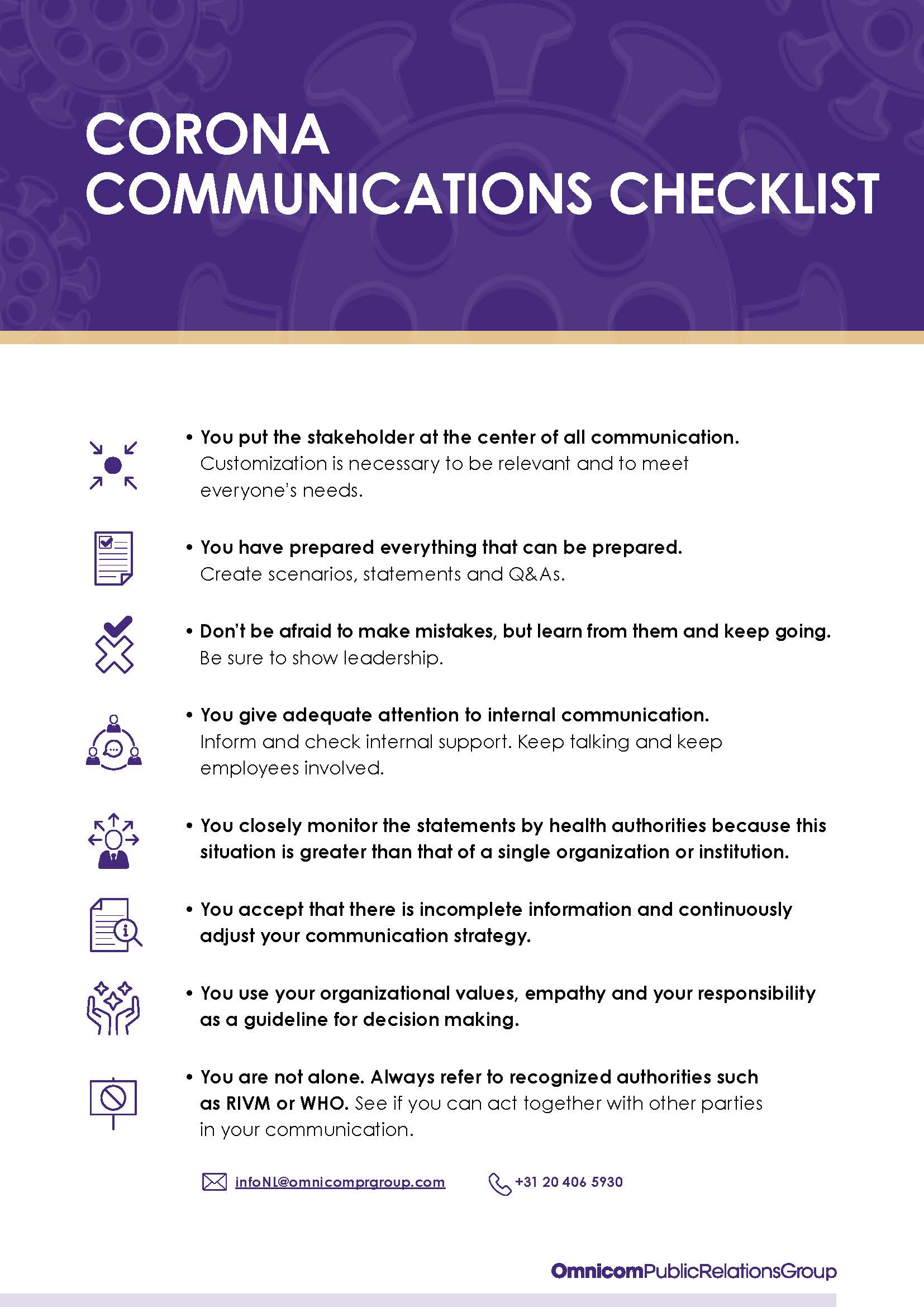Corona communication #1: What does the coronavirus mean for your reputation policy?
March 13, 2020
Strategic guidelines and questions relevant for every communication manager and HR manager in order to communicate optimally and maintain a strong reputation during the corona crisis.

The coronavirus (COVID-19) has an impact on all our daily lives and we do not yet know how big the impact will be. Of course this also has an effect on your reputation policy and therefore the way you communicate externally with customers, media, policy makers and other stakeholders. The consequences of the coronavirus on employee involvement has not yet efficiently been addressed. How do you effectively inform your employees, on all levels, about the ever-changing situation? How do you keep your employees involved now that they have to work “remotely” for longer? Tactless or lack of internal and external communication can have major consequences for your valuable relationships, your reputation and, eventually, your turnover.
Omnicom Public Relations Group lists a number of strategic guidelines and questions that are relevant for every communication manager and HR manager in order to communicate optimally and maintain a strong reputation. However, the situation is changing rapidly and with it the way in which you shape your communication policy.
Corona communications checklist
The stakeholder is central in all communication. You have carefully identified the needs and concerns of those you wish to communicate with about this outbreak. This can be customers, employees, partners and suppliers, policy makers, etc. It’s critical to understand the diverse, sometimes conflicting, needs and concerns of your key stakeholders. A tailor-made approach is necessary to be relevant and to meet everyone’s needs.
You have prepared everything that needs to be prepared. Create statements, Q&As and scenarios. Additionally, determine the moments when you may need to switch scenarios (e.g. from reactive to proactive).
Don’t be afraid to make mistakes and persevere through a crisis. Don’t wait and be sure to show leadership. Not only for external communication, but especially internally towards employees. Are they well informed and do they take it as seriously as at C-level? In other words, is there internal support?
You follow health authorities closely because this situation is greater than that of any single organization or institution. Embrace the reality that you are not the only organization dealing with the impact of this outbreak. You can rely on The World Health Organization and RIVM to provide the most accurate and up to date guidance on how companies and individuals can prevent infections.
You accept that there is incomplete information. You continuously adjust your communication strategy. Decide quickly and communicate clearly. Inconsistent, delayed, inaccurate and contradictory information was and is characteristic of this situation. Be clear about the decision-making process of the organization and keep in constant conversation with your employees. Keep your employees involved and advise them in making choices.
Align with your organizational values and use empathy and responsibility to guide your decision making. Values are a critical element of decision making, particularly in a crisis. Operate with purpose, and demonstrate both empathy and accountability as a way to acknowledge the impact of your decisions on health and economic outcomes. Is the reasoning behind your decision aligned with your stated values and purpose?
You are not alone. Refer to recognized authorities such as RIVM or WHO. Acknowledge potential complications and resistance. Even though the world is facing a new global health threat, opponents, competitors or special interest groups may seek to take advantage of the situation to negatively impact your business or your reputation. Unions, for example, can directly address the wider public from the perspective of health risks for workers. Partners or (local) authorities in the affected locations may disagree with your response or approach. See if you can interact and partner with other parties within your communications and be sure to anticipate different scenarios so that you can have a response ready.
If you have answered the previous questions mainly with “yes”, then you have a good foundation. Have you also asked yourself the following questions?
- What does the announcement of a pandemic mean worldwide and for the organization?
- Who are the stakeholders that the organization should be concerned about?
- What are the immediate concerns of your stakeholders?
- Can employees work from home? (Are all support tools for working at home arranged? Laptop, WebEx / Skype etc.)
- Are employees used to working from home? What do you tell sick employees?
- How do you communicate with employees about sick colleagues? Be sure to also consider privacy.
- How do you ensure regular updates with employees?
- What kind of guidance should you give to employees who are traveling?
- Is there a policy for employees or suppliers who have traveled to the hardest-hit regions in the past 14 days?
- How do you keep your employees engaged now that they work remotely?
- How does the organization deal with conflicting information?
- Does the organization see an economic impact as a result of this situation?
- Is it possible that there is a supply chain disruption?
- Are there internal or external events or meetings scheduled in the next three months?
And finally another hot topic: What do you do with communication regarding events? 4 tips.
- Focus on the health of employees, customers, suppliers and other stakeholders.
- When considering cancelling an event for customers, media, or internal employees, consider the following questions: what are the current guidelines set by official authorities such as RIVM or WHO? Are there a significant number of attendees/exhibitors from affected areas, and hence unable to travel? Are there alternatives available for the in-person event?
- Have a virtual plan next to each planned physical event. That way, the momentum for conveying or sharing an important message is not lost and all preparations are not for nothing. Adding value to virtual events is key. Consider special content such as e-books or whitepapers for attendees to download. Schedule online gatherings or e-meet networking opportunities. Make segments engaging with interactive chat options, live Q&A, polling or advertising for sponsors.
- Align on a comprehensive channel strategy (including social media, intranet, media relations) to ensure that all stakeholders are apprised of any change related to company events
Need help?
Omnicom Public Relations Group has established a coronavirus working group and a rapid response team, globally and locally, to support customers affected by this situation. This working group offers:
- Crisis consultation
- Response and scenario planning (Q&As, statements)
- Set up of efficient internal crisis communication
- Support in maintaining employee engagement
- Social media / web communication strategies (including training)
- Media training for spokespeople
- Stakeholder mapping and target group segmentation
- Benchmarking against competition
- Daily reports on the coronavirus and how other organizations are reacting
Let’s connect
Don’t hesitate to reach out
and discuss your challenges.
Photo by Kelly Sikkema on Unsplash.
